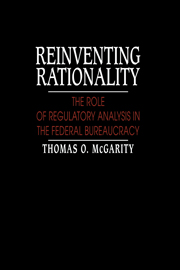Book contents
- Frontmatter
- Contents
- Acknowledgments
- Abbreviations
- Introduction
- Part I The clash of regulatory cultures
- Part II Regulatory analysis in theory and practice
- 3 Getting the lead out of gasoline: EPA's lead phasedown regulations
- 4 Getting the dust out of the air: EPA's ambient air quality standard for particulate matter
- 5 Getting obstructions out of the driver's view: NHTSA's field of direct view regulations
- 6 Getting the bone out of processed meat: FSIS's mechanically separated meat standard
- 7 Getting information into hazardous workplaces: OSHA's hazard identification regulations
- 8 The virtues of regulatory analysis
- 9 Limitations of regulatory analysis
- 10 Regulatory analysis in the real world
- Part III Structuring regulatory analysis into the decisionmaking process
- Part IV Review of regulatory analysis
- Part V Conclusions
- Notes
- Bibliography
- Index
7 - Getting information into hazardous workplaces: OSHA's hazard identification regulations
Published online by Cambridge University Press: 16 October 2009
- Frontmatter
- Contents
- Acknowledgments
- Abbreviations
- Introduction
- Part I The clash of regulatory cultures
- Part II Regulatory analysis in theory and practice
- 3 Getting the lead out of gasoline: EPA's lead phasedown regulations
- 4 Getting the dust out of the air: EPA's ambient air quality standard for particulate matter
- 5 Getting obstructions out of the driver's view: NHTSA's field of direct view regulations
- 6 Getting the bone out of processed meat: FSIS's mechanically separated meat standard
- 7 Getting information into hazardous workplaces: OSHA's hazard identification regulations
- 8 The virtues of regulatory analysis
- 9 Limitations of regulatory analysis
- 10 Regulatory analysis in the real world
- Part III Structuring regulatory analysis into the decisionmaking process
- Part IV Review of regulatory analysis
- Part V Conclusions
- Notes
- Bibliography
- Index
Summary
For many decades worker exposure to toxic substances in the workplace has taken a heavy toll. Despite the efforts of the Occupational Safety and Health Administration (OSHA) to force employers to control workplace exposure to toxic chemicals, workers still played a guinea pig role for the rest of society. As science yielded more information about chemical risks, workers began to insist that they be apprised of the risks they faced at work.
Without information about risks, workers lack the freedom to make informed career choices. They also undervalue their services in wage negotiations, because they fail to attach a risk premium to unsafe workplaces. On the other hand, evaluating and communicating risks is quite expensive, and employers are naturally reluctant to spend money informing employees when the predictable consequence will be attempts by employees to bid up wages.
Regulatory background
In 1974, the National Institute for Occupational Safety and Health (OSHA's sister agency in the Department of Health and Human Services) published a “criteria document” urging OSHA to promulgate a hazard communication standard. After an OSHA-appointed advisory committee made similar recommendations, Ralph Nader's Health Research Group in 1975 petitioned the agency to issue a standard. Two years later, OSHA published an Advance Notice of Proposed Rulemaking (ANPR) discussing some of the important issues and soliciting public comment on whether it should mandate risk communication. After spending four more years studying the responses to the ANPR, OSHA published a Notice of Proposed Rulemaking for a generic hazard identification standard as one of the many “midnight regulations” issued in the waning moments of the Carter Administration.
- Type
- Chapter
- Information
- Reinventing RationalityThe Role of Regulatory Analysis in the Federal Bureaucracy, pp. 89 - 110Publisher: Cambridge University PressPrint publication year: 1991



